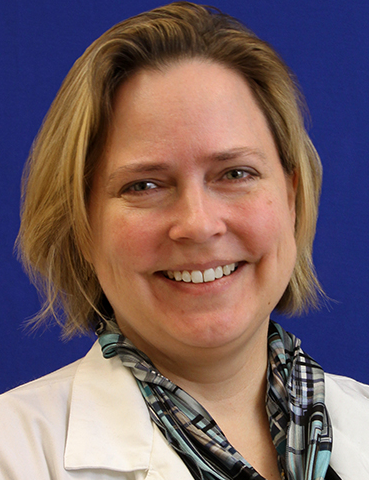08:00 | Conference Registration, Materials Pick-Up, Morning Coffee and Breakfast Pastries |
|
Session Title: Conference Plenary Session -- Emerging Themes in Circulating Biomarkers and Liquid Biopsies |
| |
|
Plenary Session Chairperson: Lucia R. Languino, Ph.D., Professor of Cancer Biology, Thomas Jefferson University |
| |
09:00 |  | Keynote Presentation Mt-SEA Pipeline: High Throughput Flow Cytometric Analysis of Exosomes in Clinical Biofluids
Jennifer Jones, NIH Stadtman Investigator, Head of Transnational Nanobiology, Laboratory of Pathology, Center for Cancer Research, National Cancer Institute, United States of America
Because Extracellular Vesicles (EVs) carry surface receptors that are
characteristic of their cells of origin, EVs have tremendous potential
as non-invasive biomarkers for diagnosis, risk-stratification, treatment
selection, and treatment monitoring. We developed a first-in-class
pipeline to characterize EV heterogeneity and provide high-sensitivity
quantification of informative EVs in biofluids before, during, and after
treatment. By combining multiplex assays with high-resolution, single
EV flow cytometric methods together into a Mutiplex-to-Single EV
Analysis (Mt-SEA) pipeline, we are able to characterize a broad range of
relevant EV subsets, while also accurately measuring the concentration
of specific EV populations. Detection of tumor-associated EVs and
detection of EV repertoire changes during treatment paves the way to
future evaluation of EVs as as biomarkers for use in personalized,
adaptive therapies. |
|
09:30 |  | Keynote Presentation Disease-Specific Vascular Markers for Cancer, Atherosclerosis and Brain Diseases
Erkki Ruoslahti, Distinguished Professor and Former President, Sanford Burnham Prebys Medical Discovery Institute, United States of America
We study peptides that home to specific targets in the body. We discover
the homing peptides by screening phage libraries for peptides that
direct homing of phages to the target tissue in vivo. The homing
peptides, which usually bind to receptors in the vessels of the target
tissue, can be used to selectively deliver diagnostic probes and drugs
to the target. The latest development is the discovery of
tumor-penetrating peptides. These peptides activate an endocytic bulk
transport pathway we have dubbed the CendR pathway, which can enhance
the exit from blood and tissue penetration co-administered compounds
even without chemical coupling to the peptide (Ruoslahti, Adv Mater.
(2012) 24 3747). We have also identified peptides specific for
atherosclerotic plaques, accumulate at the site of a brain injury or
recognize the blood vessels in Alzheimer’s disease brain. Our homing
frequency have an intrinsic biological active I the disease they target.
Examples of the peptide discovery process from initial screening to
clinical trials will be given. |
|
10:00 | Coffee Break and Networking in the Exhibit Hall |
10:45 |  | Keynote Presentation Precision Medicine Using Liquid Biopsies: A New Paradigm for Managing Cancer Diseases
Steve Soper, Foundation Distinguished Professor, Director, Center of BioModular Multi-Scale System for Precision Medicine, The University of Kansas, United States of America
Precision medicine seeks to match patients to appropriate therapies that optimize clinical outcome from molecular signatures of their disease. These molecular signatures can be secured from circulating markers found in blood (i.e., liquid biopsies). The marker types include circulating tumor cells (CTCs), cell-free DNA (cfDNA), and nanoscale vesicles (exosomes). Unfortunately, many disease-associated blood markers are a vast minority in a mixed population making them difficult to analyze due to deficiencies in current technologies used for their isolation. To address this deficiency, we are generating innovative microfluidic tools for selecting circulating markers from whole blood and determining the presence/absence of disease-specific molecular signatures secured from the liquid biopsy markers to guide therapy for a patient. The microfluidics can process whole blood (=1 mL) and search for CTCs, cfDNA, or exosomes and make them available for downstream molecular processing. The microfluidics are made in plastics via injection molding, making them particularly attractive for clinical implementation, which demands low-cost disposables. In this keynote address, I will discuss our microfluidic platforms for CTC, cfDNA, and exosome isolation. The exosome chip consists of 1.4 million pillars that contain surface-immobilized antibodies directed against antigens from cancer cells that are epithelial based (EpCAM) and those with a mesenchymal phenotype (fibrobast activation protein alpha, FAPa). I will then talk extensively about our exosome isolation chip, and its use in several clinical examples and securing molecular information from the affinity-selected exosomes. |
|
11:15 |  | Conference Chair Exosomes: Novel Opportunities for the Diagnosis and Therapy of Cancer
Lucia Languino, Professor of Cancer Biology, Thomas Jefferson University, United States of America
Our studies have revealed a role for Integrins in mediating
extracellular vesicle (EV) functions. We have demonstrated a cross-talk
between prostate cancer cells and monocytes that promotes
pro-tumorigenic M2 polarization. We have shown that this cross-talk is
mediated by the alphavß6 integrin in EVs and have suggested that
inhibition of this integrin and its downstream effectors might offer a
novel immune – based therapeutic strategy in prostate cancer. We also
demonstrate that the EVs circulating in plasma from prostate cancer
patients contain higher levels of a different integrin, alphavß3, and
CD9 as compared to plasma EVs from age-matched subjects who are not
affected by cancer. We show that the EVs present in plasma from
prostate cancer patients contain higher levels of alphavß3 and CD9 as
compared to plasma EVs from age-matched subjects who are not affected by
cancer. Furthermore, using PSMA antibody-bead mediated immunocapture,
we show that the alphavß3 integrin is expressed in a subset of EVs
characterized by PSMA, CD9, CD63, and an epithelial-specific marker,
Trop-2. Our results suggest that detecting alphavß3 integrin in
prostate cancer patient EVs could be a clinically useful and
non-invasive biomarker to follow prostate cancer progression. |
|
11:45 |  | Keynote Presentation Tumor-derived Exosomes Contribute to a Pro-inflammatory Tumor Microenvironment through the Stimulation of Chemokines and Cytokines in Mesenchymal Stromal Cells and Macrophages
Yves A. DeClerck, Professor of Pediatrics and Biochemistry & Molecular Medicine, Children’s Hospital Los Angeles, University of Southern California, United States of America
Exosomes are members of a large family of extracellular vesicles
involved in cell-cell communication that play important regulatory
functions in physiological and pathological conditions. Using
neuroblastoma (NB), the second most common solid tumor in children and a
cancer that is highly metastatic to the bone marrow and the liver as a
model, we show that NB-derived exosomes contribute to the stimulation of
several protumorigenic cytokines and chemokines (IL-6, IL-8, MCP-1,
VEGF) by mesenchymal stromal cells (MSC) and macrophages via ERK1/2
activation. In vivo NB-derived exosomes are also preferentially
captured by macrophages at the site of metastasis (bone marrow and
liver). Altogether these cytokines promotes the proliferation of tumor
cells, their resistance to chemotherapy and immune escape via STAT3 and
ERK1/2 activation. |
|
12:15 | Networking Lunch in the Exhibit Hall and Poster Viewing |
|
Session Title: Circulating Cell-Free DNA (cfDNA) -- A Valuable Circulating Biomarker for Liquid Biopsy Development |
| |
14:00 | Ultrasensitive Detection of Cancer Using cfDNA Methylation Sequencing
Jasmine Zhou, Professor, University of California-Los Angeles, United States of America
The detection of tumor-derived cell-free DNA in plasma is one of the
most promising directions in cancer diagnosis. The major challenge in
such an approach is how to identify the tiny amount of tumor DNAs out of
total cell-free DNAs in blood. Here we propose an ultrasensitive cancer
detection method, termed ‘CancerDetector’, using the DNA methylation
profiles of cell-free DNAs. The key of our method is to
probabilistically model the joint methylation states of multiple
adjacent CpG sites on an individual sequencing read, in order to exploit
the pervasive nature of DNA methylation for signal amplification.
Therefore, CancerDetector can sensitively identify a trace amount of
tumor cfDNAs in plasma, at the level of individual reads. Testing
CancerDetector on real plasma data demonstrated its high sensitivity and
specificity in detecting tumor cfDNAs. In addition, the predicted tumor
fraction showed great consistency with tumor size and survival outcome.
Note that all of those testing were performed on sequencing data at low
to medium coverage (1× to 10×). Therefore, CancerDetector holds the
great potential to detect cancer early and cost-effectively. |
14:30 |  Multiple Biomarker Analysis: New Approaches and Workflow Solutions Multiple Biomarker Analysis: New Approaches and Workflow Solutions
Martin Schlumpberger, Associate Director, Scientific Applications, QIAGEN
Isolation of circulating cell-free biomarkers from different types of body fluids and different entities within these samples, such as circulating tumor cells (CTC) or exosomes and other extracellular vesicles (EVs), poses diverse challenges that need to be addressed. QIAGEN recently released new solutions that include exoRNeasy protocols for isolation of short and long RNAs from EVs in urine, or isolation of cell-free miRNA in higher throughput. Our data demonstrate that utilizing different technology approaches in combined workflows allows collection of meaningful biological data at unprecedented depth, enabling new insights into pathological processes that have a direct impact on clinical research parameters, such as survival statistics.
The applications presented are for molecular biology use only. Not for use in diagnostic procedures.
|
15:00 | Ultra-Sensitive Mutational Analysis in Cell-Free DNA by Digital PCR and NGS Technologies
Rachel Tam, Senior Scientific Researcher, Oncology Biomarker Development, Genentech, United States of America
Circulating cell-free DNA (cfDNA) in plasma offers a non-invasive approach to monitor tumor molecular profiling in real-time at multiple time-points, detection of emerging genomic alterations associated with drug resistance and clarifying cancer prognosis and diagnosis of cancer recurrence or progression. We developed an ultra-sensitive droplet digital PCR (ddPCR) approach and molecular tagged NGS technologies to detect actionable cancer biomarkers in cfDNA. |
15:30 | Afternoon Coffee Break in the Exhibit Hall |
16:00 | Early Cancer Detection in Plasma by Methylation Haplotyping
Kun Zhang, Professor, Department of Bioengineering, University of California San Diego, United States of America
Adjacent CpG sites in mammalian genomes tend to be co-methylated due to the processivity of enzymes responsible for adding or removing the methyl group. This pattern, called methylation haplotypes, can be utilized to detect low levels of circulating DNA from tumor or tumor-residing tissues in the blood. We have developed NGS-based targeted methylation sequencing assays for early detection and location of multiple cancer types in the plasma. In this talk I’ll discuss the underlying principles and present the results on over 3000 samples from multiple cohorts. |
16:30 | Monitoring Recurrence With Personalized ctDNA Assays
Bernhard Zimmermann, Vice President of Research and Development, Natera, United States of America
Signatera™ RUO is the first individualized pan-cancer circulating tumor DNA platform. I will be showing results of validation studies for monitoring treatment response, detecting minimal residual disease and predicting disease recurrence. The test detects tumor DNA down to 0.01% VAF (tumor fraction) and data from clinical studies in lung cancer, bladder cancer, colorectal cancer and breast cancer show that ctDNA is detected in plasma of patients up to over one year ahead of clinical detection of relapse. |
17:00 | cfDNA Analysis in ALK-positive NSCLC Patients and Potential Clinical Utility
Jean-François Martini, Sr. Director, Translational Oncology, Immuno-Oncology, Early Development, Pfizer, United States of America
Lorlatinib exhibited antitumor activity across a variety of ALK kinase domain resistance mutations, including the difficult-to-treat ALK G1202R mutation. Responses to lorlatinib were also seen in patients resistant to prior ALK TKIs and without detectable ALK resistance mutations in plasma. |
17:30 |  | Keynote Presentation Nanodiagnostic Tool for Comprehensive Assessment of Cancer in Blood
Shan Wang, Leland T. Edwards Professor in the School of Engineering, Stanford University, United States of America
Blood borne biomarkers, such as secreted proteins, circulating tumor DNA
(ctDNA) and circulating tumor cell (CTC), have garnered much attention
as minimally invasive cancer biomarkers for the “liquid biopsy” of
tumors over the past decade. In this talk, we will describe three
magnetic-nanoparticle-based diagnostic tools that have been used to
assess cancer in peripheral blood successfully: 1) Stanford spin-off
MagArray Inc. has launched REVEAL, a cancer-specific blood test that may
aid clinicians in characterizing indeterminate pulmonary nodules
(4-30mm) in current smokers aged 25-85. The REVEAL Score is calculated
using an algorithm based on the measurement of 3 clinical factors and 3
blood proteins associated with the presence of lung cancer. The assay is
optimized to rule out lung cancer with a negative predictive value
(NPV) of = 95%. 2) We have developed sequence-specific capture of
hypermethylated or mutated genes of interest from cfDNA for early
detection of NSCLC and colorectal cancer (CRC). With downstream analysis
of PCR products on giant magnetoresistive (GMR) biosensors and
high-resolution melt analysis for a highly multiplexable assay, we have
achieved a sensitivity of 0.01% mutant/methylated allele fractions. Our
optimized assay has the ability to detect down to 16 pg (~4 genome
equivalents) of hypermethylated DNA spiked-in to 3.5 mL of plasma. 3) We
have utilized the MagSifter and immunocytochemistry combined with
automated image analysis and machine learning techniques (random forest,
transfer learning) for the enumeration and diagnosis/prognosis of NSCLC
derived CTCs in patient samples, which are well suited for therapy
selection and monitoring. |
|
18:00 | Networking Reception with Beer and Wine in the Exhibit Hall |
19:00 | Close of Day 1 of the Conference. |
19:30 | Start of Exosomes/Extracellular Vesicles (EV) Training Course [Separate Registration Required to Attend this Training Course] |














